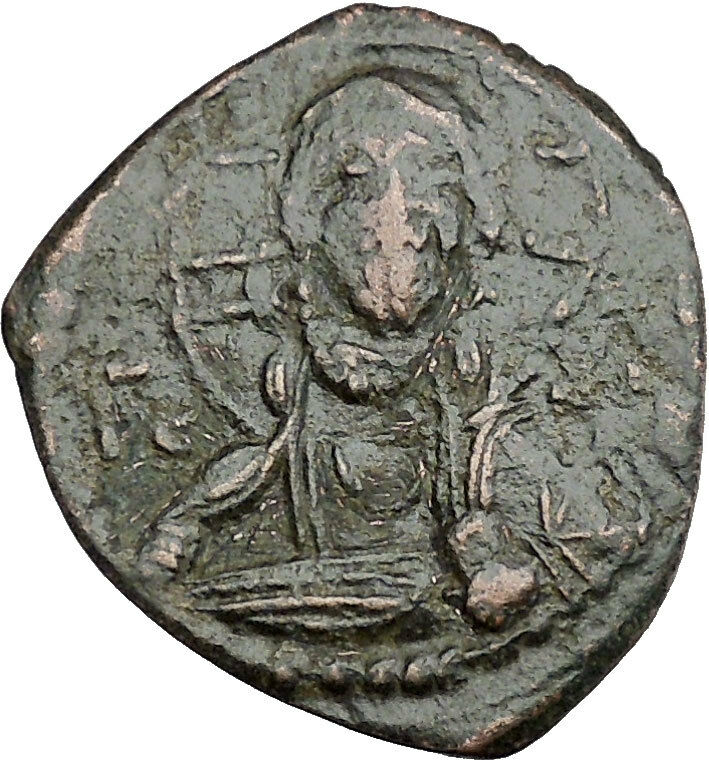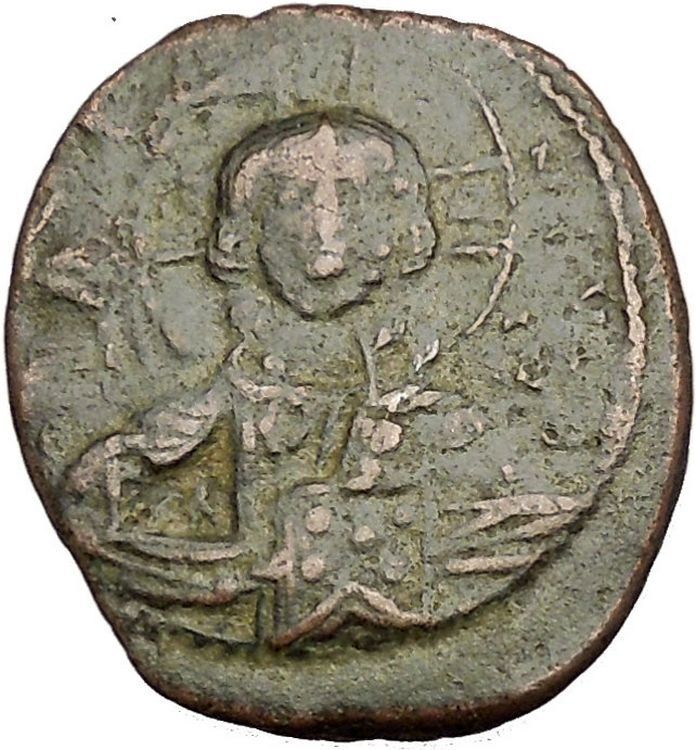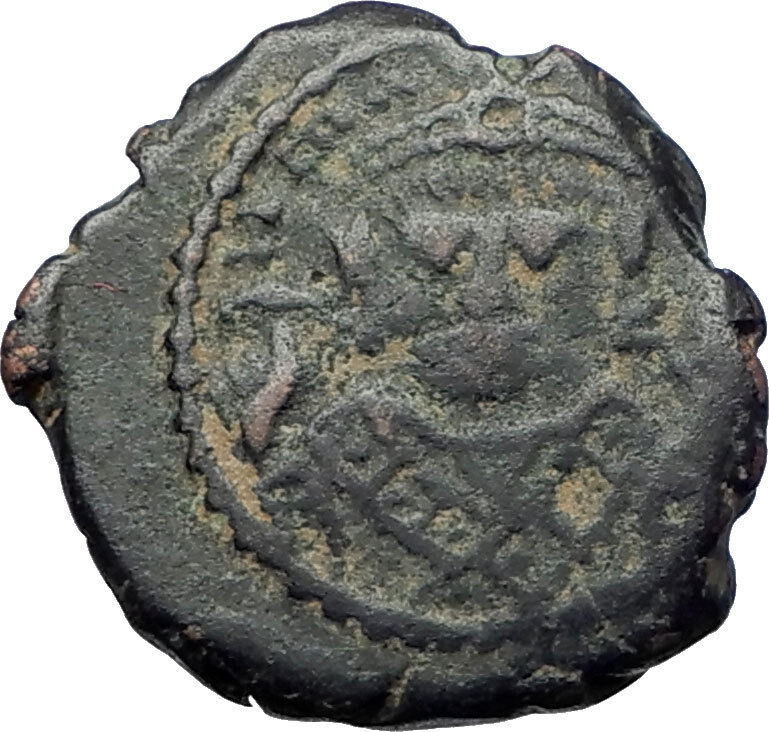|
Byzantine Empire – Anonymous Class C
Bronze Follis 31mm (11.84 grams) Struck during the reign of Michael IV 1034-1041 A.D.
Reference: Sear 1825
+ЄMMANOVHΛ – Three-quarter length figure of Christ Antiphonetes standing facing, wearing nimbus crown, pallium and colobium, and raising right hand in benediction; in left hand, book of Gospels; in field to left, IC; to right, XC.
Jeweled cross cross, with pellet at each extremity; in the angles, IC -XC / NI – KA (“May Jesus Christ Conquer”).
For more than a century, the production of Follis denomination Byzantine coins had religious Christian motifs which included included Jesus Christ, and even Virgin Mary. These coins were designed to honor Christ and recognize the subservient role of the Byzantine emperor, with many of the reverse inscriptions translating to “Jesus Christ King of Kings” and “May Jesus Christ Conquer”. The Follis denomination coins were the largest bronze denomination coins issued by the Byzantine empire, and their large size, along with the Christian motif make them a popular coin type for collectors. This series ran from the period of Byzantine emperors John I (969-976 A.D.) to Alexius I (1081-1118 A.D.). The accepted classification was originally devised by Miss Margaret Thompson with her study of these types of coins. World famous numismatic author, David R. Sear adopted this classification system for his book entitled, Byzantine Coins and Their Values. The references about this coin site Mr. Sear’s book by the number that they appear in that work. The class types of coins included Class A1, Class A2, Class B, Class C, Class D, Class E, Class F, Class G, Class H, Class I, Class J, Class K.
-
Read the JESUS CHRIST Anonymous Class A-N Byzantine Follis Coins Reference and Guide
-
See ALL the Jesus Christ Anonymous Follis coins for sale.
-
See ALL coins bearing Jesus Christ or related available for sale.
You are bidding on the exact item pictured, provided with a Certificate of Authenticity and Lifetime Guarantee of Authenticity.
 Jesus (7-2 BC to AD 30-33), also referred to as Jesus of Nazareth or Jesus Christ, is the central figure of Christianity, whom the teachings of most Christian denominations hold to be the Son of God. Christians believe Jesus is the awaited Messiah (or Christ, the Anointed One) of the Old Testament. Jesus (7-2 BC to AD 30-33), also referred to as Jesus of Nazareth or Jesus Christ, is the central figure of Christianity, whom the teachings of most Christian denominations hold to be the Son of God. Christians believe Jesus is the awaited Messiah (or Christ, the Anointed One) of the Old Testament.
Virtually all modern scholars of antiquity agree that Jesus existed historically, and historians consider the Synoptic Gospels (Matthew, Mark and Luke) to be the best sources for investigating the historical Jesus. Most scholars agree that Jesus was a Galilean, Jewish rabbi who preached his message orally, was baptized by John the Baptist, and was crucified by the order of the Roman Prefect Pontius Pilate. In the current mainstream view, Jesus was an apocalyptic preacher and the founder of a renewal movement within Judaism, although some prominent scholars argue that he was not apocalyptic. After Jesus’ death, his followers believed he was resurrected, and the community they formed eventually became the Christian church. The widely used calendar era, abbreviated as “AD” from the Latin “Anno Domini” (“in the year of our Lord”) or sometimes as “CE”, is based on the birth of Jesus.
 Christians believe that Jesus has a “unique significance” in the world. Christian doctrines include the beliefs that Jesus was conceived by the Holy Spirit, was born of a virgin named Mary, performed miracles, founded the Church, died by crucifixion as a sacrifice to achieve atonement, rose from the dead, and ascended into Heaven, whence he will return. Most Christians believe Jesus enables humans to be reconciled to God, and will judge the dead either before or after their bodily resurrection, an event tied to the Second Coming of Jesus in Christian eschatology; though some believe Jesus’s role as savior has more existential or societal concerns than the afterlife, and a few notable theologians have suggested that Jesus will bring about a universal reconciliation. The great majority of Christians worship Jesus as the incarnation of God the Son, the second of three persons of a Divine Trinity. A few Christian groups reject Trinitarianism, wholly or partly, as non-scriptural. Christians believe that Jesus has a “unique significance” in the world. Christian doctrines include the beliefs that Jesus was conceived by the Holy Spirit, was born of a virgin named Mary, performed miracles, founded the Church, died by crucifixion as a sacrifice to achieve atonement, rose from the dead, and ascended into Heaven, whence he will return. Most Christians believe Jesus enables humans to be reconciled to God, and will judge the dead either before or after their bodily resurrection, an event tied to the Second Coming of Jesus in Christian eschatology; though some believe Jesus’s role as savior has more existential or societal concerns than the afterlife, and a few notable theologians have suggested that Jesus will bring about a universal reconciliation. The great majority of Christians worship Jesus as the incarnation of God the Son, the second of three persons of a Divine Trinity. A few Christian groups reject Trinitarianism, wholly or partly, as non-scriptural.
In Islam, Jesus (commonly transliterated as Isa) is considered one of God’s important prophets and the Messiah, second in importance only to Muhammad. To Muslims, Jesus was a bringer of scripture and was born of a virgin, but was not the Son of God. According to the Quran, Jesus was not crucified but was physically raised into Heaven by God. Judaism rejects the belief that Jesus was the awaited Messiah, arguing that he did not fulfill the Messianic prophecies in the Tanakh.
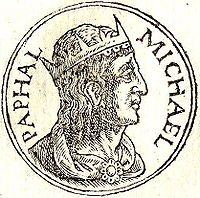 Michael IV the Paphlagonian (Greek: Mikhaēl IV Paphlagōn), (1010 – December 10, 1041), was Eastern Roman Emperor from April 11, 1034 to December 10, 1041. He owed his elevation to Empress Zoe, daughter of Emperor Constantine VIII and wife of Romanos III Argyros. Michael IV the Paphlagonian (Greek: Mikhaēl IV Paphlagōn), (1010 – December 10, 1041), was Eastern Roman Emperor from April 11, 1034 to December 10, 1041. He owed his elevation to Empress Zoe, daughter of Emperor Constantine VIII and wife of Romanos III Argyros.
Michael came from a family of Paphlagonian peasants, one of whom, the parakoimomenos John the Eunuch had come to preside over the woman’s quarters at the imperial palace. John brought his younger brothers into the court and there the empress Zoe became enamoured of Michael, who became her chamberlain. Zoe and Michael decided to use a slow poison to kill Zoe’s husband Romanos III. However, becoming impatient with the poison, they drowned him and Zoe immediately married Michael, on April 11, 1034. Michael IV was also proclaimed emperor and reigned together with Zoe until his death in 1041.
Michael IV was handsome, clever, and generous, but he was uneducated and suffered from epileptic fits. Therefore he left the government in the hands of his brother John, who had already become an influential minister of Constantine VIII and Romanos III. John’s reforms of the army and financial system revived for a while the strength of the Empire, which held its own successfully against its foreign enemies. But the increase in taxation caused discontent among both nobles and commoners. John’s monopoly of the government led to several failed conspiracies against him in 1034, 1037, 1038, and 1040 one of which was led by the Empress Zoe herself. The last conspiracy involved the patrician Michael Keroularios, who became a monk to save his life and was later elected as patriarch of Constantinople.
On the eastern frontier the important fortress of Edessa was relieved after a prolonged siege. On the western front the Muslims were almost driven out of Sicily by George Maniakes (who campaigned there between 1037 and 1040). Maniakes fell out with his Lombard allies, however, and lost the support of the Lombards and Normans. After the recall of Maniakes most of the Sicilian conquests were lost (1041), and a subsequent expedition against the Italian Normans suffered several defeats.
In the north the Serbs revolted successfully in 1040, as did the Bulgarians in western Bulgaria and Macedonia in the same year. This revolt was partly caused by the heavy taxation in coin imposed on Bulgaria at the time, but it aimed at the restoration of the Bulgarian state under the leadership of Peter Delyan. Although Michael IV was chased out of the vicinity of Thessalonica by the rebels, he returned with an army of 40,000 men in 1041 assisted by Norse mercenaries including the future King Harald III of Norway. The military success of the Romans was aided by internal dissention among the Bulgarians and eventually their leaders were defeated and captured. Michael IV returned to Constantinople in triumph but he was now decrepit with illness and died on December 10, 1041.
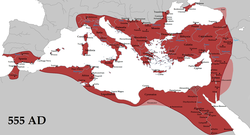 The Byzantine Empire, or Eastern Roman Empire, was the predominantly Greek-speaking eastern half continuation and remainder of the Roman Empire during Late Antiquity and the Middle Ages. Its capital city was Constantinople (modern-day Istanbul), originally founded as Byzantium. It survived the fragmentation and fall of the Western Roman Empire in the 5th century AD and continued to exist for an additional thousand years until it fell to the Ottoman Turks in 1453. During most of its existence, the empire was the most powerful economic, cultural, and military force in Europe. Both “Byzantine Empire” and “Eastern Roman Empire” are historiographical terms created after the end of the realm; its citizens continued to refer to their empire as the Roman Empire (Ancient Greek: Βασιλεία Ῥωμαίων, tr. Basileia Rhōmaiōn; Latin: Imperium Romanum), or Romania (Ῥωμανία), and to themselves as “Romans”. The Byzantine Empire, or Eastern Roman Empire, was the predominantly Greek-speaking eastern half continuation and remainder of the Roman Empire during Late Antiquity and the Middle Ages. Its capital city was Constantinople (modern-day Istanbul), originally founded as Byzantium. It survived the fragmentation and fall of the Western Roman Empire in the 5th century AD and continued to exist for an additional thousand years until it fell to the Ottoman Turks in 1453. During most of its existence, the empire was the most powerful economic, cultural, and military force in Europe. Both “Byzantine Empire” and “Eastern Roman Empire” are historiographical terms created after the end of the realm; its citizens continued to refer to their empire as the Roman Empire (Ancient Greek: Βασιλεία Ῥωμαίων, tr. Basileia Rhōmaiōn; Latin: Imperium Romanum), or Romania (Ῥωμανία), and to themselves as “Romans”.
Several events from the 4th to 6th centuries mark the transitional period during which the Roman Empire’s east and west divided. In 285, the emperor Diocletian (r. 284-305) partitioned the Roman Empire’s administration into eastern and western halves. Between 324 and 330, Constantine I (r. 306-337) transferred the main capital from Rome to Byzantium, later known as Constantinople (“City of Constantine”) and Nova Roma (“New Rome”). Under Theodosius I (r. 379-395), Christianity became the Empire’s official state religion and others such as Roman polytheism were proscribed. And finally, under the reign of Heraclius (r. 610-641), the Empire’s military and administration were restructured and adopted Greek for official use instead of Latin. Thus, although it continued the Roman state and maintained Roman state traditions, modern historians distinguish Byzantium from ancient Rome insofar as it was oriented towards Greek rather than Latin culture, and characterised by Orthodox Christianity rather than Roman polytheism.
The borders of the Empire evolved significantly over its existence, as it went through several cycles of decline and recovery. During the reign of Justinian I (r. 527-565), the Empire reached its greatest extent after reconquering much of the historically Roman western Mediterranean coast, including north Africa, Italy, and Rome itself, which it held for two more centuries. During the reign of Maurice (r. 582-602), the Empire’s eastern frontier was expanded and the north stabilised. However, his assassination caused a two-decade-long war with Sassanid Persia which exhausted the Empire’s resources and contributed to major territorial losses during the Muslim conquests of the 7th century. In a matter of years the Empire lost its richest provinces, Egypt and Syria, to the Arabs.
During the Macedonian dynasty (10th-11th centuries), the Empire again expanded and experienced a two-century long renaissance, which came to an end with the loss of much of Asia Minor to the Seljuk Turks after the Battle of Manzikert in 1071. This battle opened the way for the Turks to settle in Anatolia as a homeland.
The final centuries of the Empire exhibited a general trend of decline. It struggled to recover during the 12th century, but was delivered a mortal blow during the Fourth Crusade, when Constantinople was sacked and the Empire dissolved and divided into competing Byzantine Greek and Latin realms. Despite the eventual recovery of Constantinople and re-establishment of the Empire in 1261, Byzantium remained only one of several small rival states in the area for the final two centuries of its existence. Its remaining territories were progressively annexed by the Ottomans over the 15th century. The Fall of Constantinople to the Ottoman Empire in 1453 finally ended the Byzantine Empire.
|





 Jesus (7-2 BC to AD 30-33), also referred to as Jesus of Nazareth or Jesus Christ, is the central figure of Christianity, whom the teachings of most Christian denominations hold to be the Son of God. Christians believe Jesus is the awaited Messiah (or Christ, the Anointed One) of the Old Testament.
Jesus (7-2 BC to AD 30-33), also referred to as Jesus of Nazareth or Jesus Christ, is the central figure of Christianity, whom the teachings of most Christian denominations hold to be the Son of God. Christians believe Jesus is the awaited Messiah (or Christ, the Anointed One) of the Old Testament. Christians believe that Jesus has a “unique significance” in the world. Christian doctrines include the beliefs that Jesus was conceived by the Holy Spirit, was born of a virgin named Mary, performed miracles, founded the Church, died by crucifixion as a sacrifice to achieve atonement, rose from the dead, and ascended into Heaven, whence he will return. Most Christians believe Jesus enables humans to be reconciled to God, and will judge the dead either before or after their bodily resurrection, an event tied to the Second Coming of Jesus in Christian eschatology; though some believe Jesus’s role as savior has more existential or societal concerns than the afterlife, and a few notable theologians have suggested that Jesus will bring about a universal reconciliation. The great majority of Christians worship Jesus as the incarnation of God the Son, the second of three persons of a Divine Trinity. A few Christian groups reject Trinitarianism, wholly or partly, as non-scriptural.
Christians believe that Jesus has a “unique significance” in the world. Christian doctrines include the beliefs that Jesus was conceived by the Holy Spirit, was born of a virgin named Mary, performed miracles, founded the Church, died by crucifixion as a sacrifice to achieve atonement, rose from the dead, and ascended into Heaven, whence he will return. Most Christians believe Jesus enables humans to be reconciled to God, and will judge the dead either before or after their bodily resurrection, an event tied to the Second Coming of Jesus in Christian eschatology; though some believe Jesus’s role as savior has more existential or societal concerns than the afterlife, and a few notable theologians have suggested that Jesus will bring about a universal reconciliation. The great majority of Christians worship Jesus as the incarnation of God the Son, the second of three persons of a Divine Trinity. A few Christian groups reject Trinitarianism, wholly or partly, as non-scriptural. Michael IV the Paphlagonian (Greek: Mikhaēl IV Paphlagōn), (1010 – December 10, 1041), was Eastern Roman Emperor from April 11, 1034 to December 10, 1041. He owed his elevation to Empress Zoe, daughter of Emperor Constantine VIII and wife of Romanos III Argyros.
Michael IV the Paphlagonian (Greek: Mikhaēl IV Paphlagōn), (1010 – December 10, 1041), was Eastern Roman Emperor from April 11, 1034 to December 10, 1041. He owed his elevation to Empress Zoe, daughter of Emperor Constantine VIII and wife of Romanos III Argyros. The Byzantine Empire, or Eastern Roman Empire, was the predominantly Greek-speaking eastern half continuation and remainder of the Roman Empire during Late Antiquity and the Middle Ages. Its capital city was Constantinople (modern-day Istanbul), originally founded as Byzantium. It survived the fragmentation and fall of the Western Roman Empire in the 5th century AD and continued to exist for an additional thousand years until it fell to the Ottoman Turks in 1453. During most of its existence, the empire was the most powerful economic, cultural, and military force in Europe. Both “Byzantine Empire” and “Eastern Roman Empire” are historiographical terms created after the end of the realm; its citizens continued to refer to their empire as the Roman Empire (Ancient Greek: Βασιλεία Ῥωμαίων, tr. Basileia Rhōmaiōn; Latin: Imperium Romanum), or Romania (Ῥωμανία), and to themselves as “Romans”.
The Byzantine Empire, or Eastern Roman Empire, was the predominantly Greek-speaking eastern half continuation and remainder of the Roman Empire during Late Antiquity and the Middle Ages. Its capital city was Constantinople (modern-day Istanbul), originally founded as Byzantium. It survived the fragmentation and fall of the Western Roman Empire in the 5th century AD and continued to exist for an additional thousand years until it fell to the Ottoman Turks in 1453. During most of its existence, the empire was the most powerful economic, cultural, and military force in Europe. Both “Byzantine Empire” and “Eastern Roman Empire” are historiographical terms created after the end of the realm; its citizens continued to refer to their empire as the Roman Empire (Ancient Greek: Βασιλεία Ῥωμαίων, tr. Basileia Rhōmaiōn; Latin: Imperium Romanum), or Romania (Ῥωμανία), and to themselves as “Romans”.


